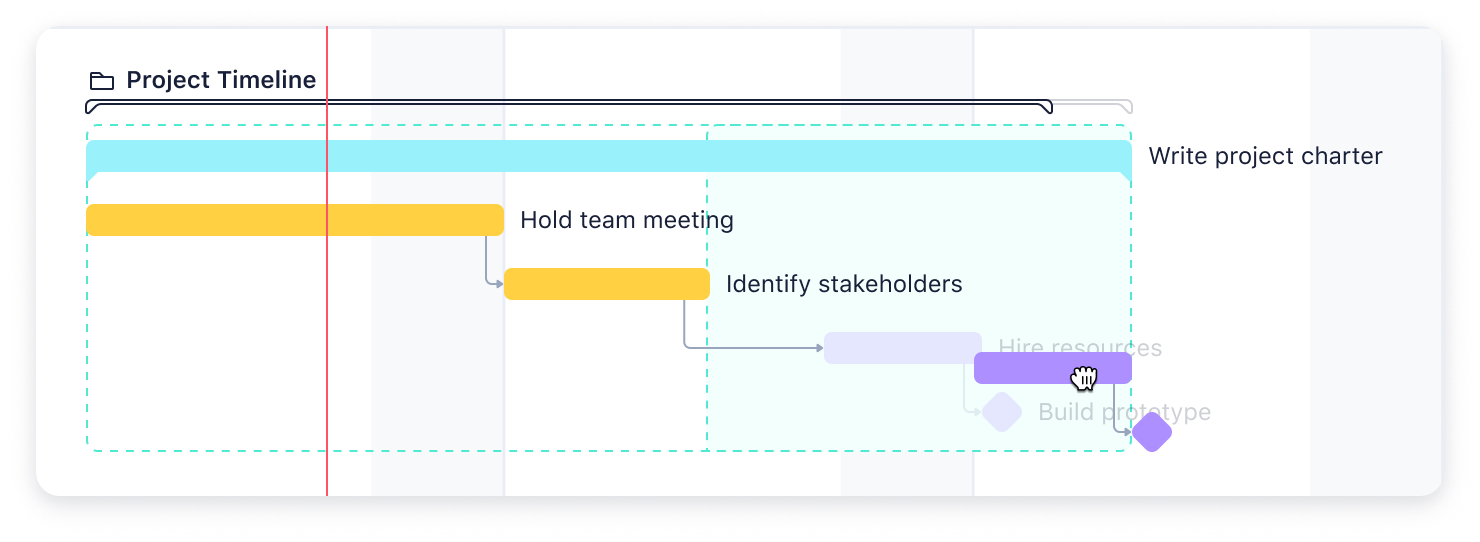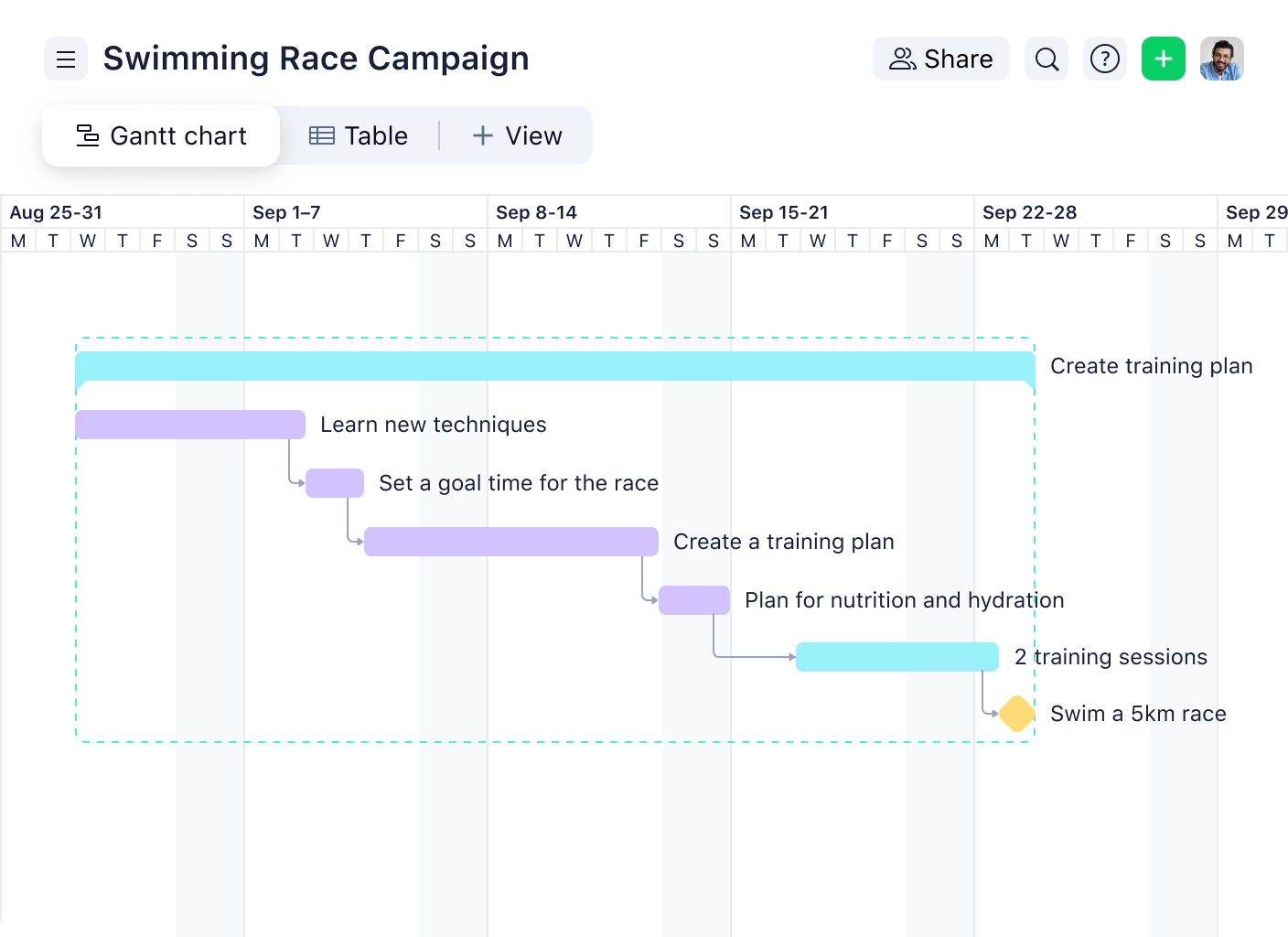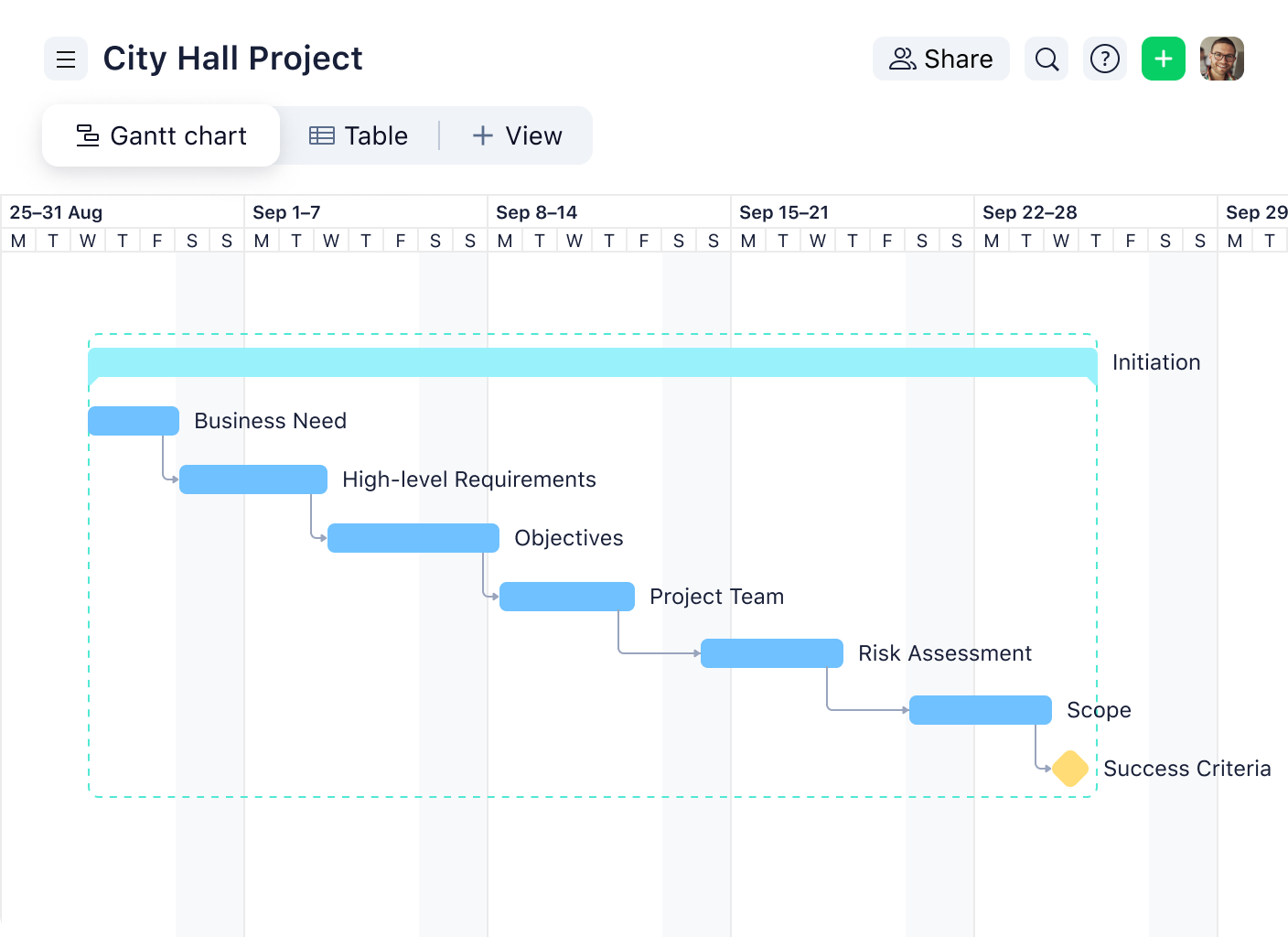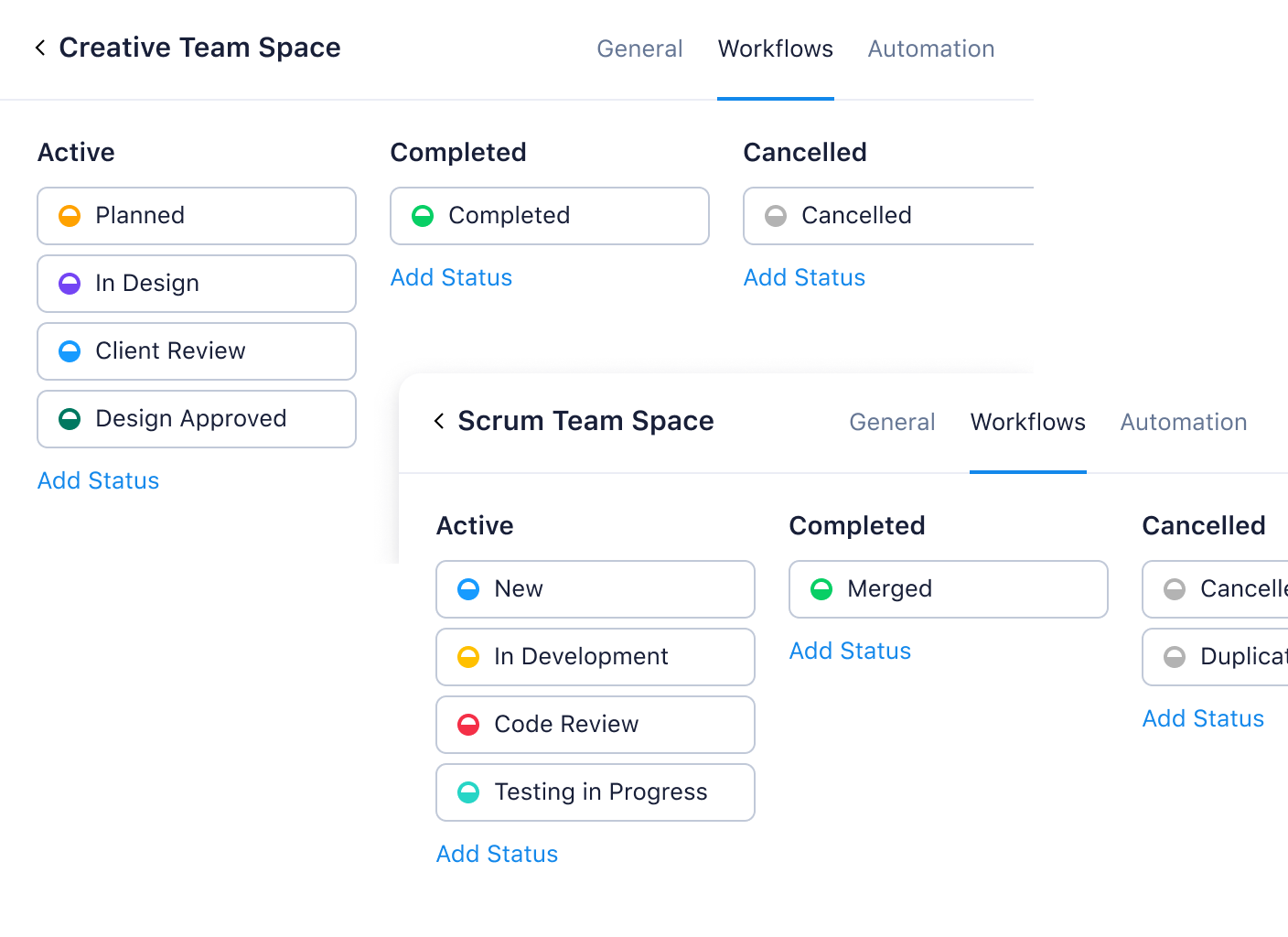Project Charter: Guide With Examples and Template

What is a project charter?
A project charter is a formal document that officially kicks off a project. It explains the project purpose, goals, and scope, outlines key tasks, and identifies who’s responsible for what deliverables. The charter gives the project manager the green light to start work and aligns the team from day one.
Essentially, a project charter works like a project’s roadmap. It communicates exactly what the project is about, who’s involved, and how it will be done. It’s the go-to guide for all project decisions, helping keep the project on track and aligned with its original goals.
I have seen firsthand how a project charter prevents scope creep and budget overruns by providing a written reference throughout the project. It also emphasizes stakeholder consideration, ensuring the project aligns with expectations and standards.
In this article, we’ll take a closer look at the project charter definition and what it entails. I’ll talk about the benefits it brings as well as tips for writing one. And I’ll also share a project charter example, with all the essential components.
With Wrike, you can easily create and customize project charters to suit your specific project needs, streamlining the planning process and increasing productivity for an improved return on investment. Experience the benefits for yourself today.
What is a project charter in project management?
In project management, a project charter is the foundation of a successful project, offering clarity and direction to the team and ensuring everyone is on the same page.
When starting a new project, it’s essential to have a clear plan in place to ensure project success. That’s where a project charter comes in.
According to the Project Management Institute (PMI), ‘’The project charter is used as a reference throughout the project to ensure that the project scope does not change.’’
As a primary project timeline reference document, the project charter is there to help you navigate issues that arise proactively. In a sense, it’s to the project manager what a blueprint is to an architect. It gives you an overview of the project in its entirety.

Project charter vs. project plan: What’s the difference?
Easy to confuse, the project charter and project management plan share similarities but serve different purposes.
From my experience, the project charter is a high-level strategic overview that seeks to lay out the terms of the project, along with other key details such as relevant stakeholder information. It’s what I rely on to provide the parameters within which my team must operate in order for the project to be a success.
A project charter is typically created at the initiation stage of the project. When I pitch a project, the project charter helps stakeholders understand the rationale behind the project and its potential value.

The project plan is more of a nuts-and-bolts outline that explains how you’ll go about executing the project on a tactical level. It is developed after the project charter has been approved. In the project plan, there should be a greater emphasis on specific actions, processes, and workflows that will help you complete your work efficiently and to a high standard.
What’s the purpose of a project charter?
The main reason I put together a project charter is to establish the direction, framework, and guidelines for an upcoming project. From my experience, it’s one document everyone on the team can refer back to for guidance, which can help to avoid costly mistakes and setbacks.
I often compare a project charter to an essay plan.
Before writing an essay, you would normally:
- Research to find data that supports your claims
- Create a skeleton structure for your argument
- Identify and address reader objections so you can answer the questions that might emerge in the reader’s mind
Contained within a project charter document, the data incorporates all relevant details that are necessary to complete the project. Using that data, you follow a similar process to an essay, where you identify potential objections, which then become challenges that need to be overcome. These objections could come from team members, sponsors, clients, or other project stakeholders.
For example, objections might include budget constraints, conflicting priorities, resource limitations, or technical problems. By identifying these potential objections early on and acknowledging them in the project charter, the team can proactively plan how to overcome challenges during the project’s execution.
Without the benefits of a project charter, you’re forced to fumble your way through the project, finding solutions for emerging problems on the fly.
Another goal of a project charter is to sell the project to stakeholders by demonstrating its worth related to business needs. This helps stakeholders understand the value proposition and the project’s potential return on investment. It also serves as a communication tool, ensuring transparency and alignment among stakeholders regarding project expectations and commitments. In essence, it’s like making a pitch to get stakeholders firmly on board and excited about the project.
The project charter overview
The project charter typically documents the following parts of the project:
- Project objectives and constraints
- Key stakeholders
- Risks identified
- Benefits of the project
- General overview of the budget
- Success metrics

Project objectives and constraints
First, outline what your main objectives are for the project. These objectives should be SMART: specific, measurable, achievable, realistic, and time-bound.
I have found that having SMART objectives helps guide the project team. It also serves as a persuasive tool when selling the project to stakeholders, making them more likely to understand the project’s purpose and feel confident in its feasibility.
Then, identify potential constraints or obstacles that could prevent you from achieving them.
When considering constraints, think about your available budget, team member capacity and general resource management, and other factors such as stakeholder requirements.
Timeline
Map out the estimated start and end dates for the project, along with any milestones you should hit along the way. You can then translate this information to a dynamic timeline model in your project management software to track project progress in real time.
Key stakeholders
Identify and list every stakeholder with a vested interest in the project and its success. Detail what their role is in relation to the project, what you might need from them, and how you can contact them.
Risks identified
Create a risk management plan for mitigating or avoiding risks that pose a threat to the completion of your project. First, identify what they might be, then figure out what the best course of action would be for each.
Benefits of the project
Consider and describe how the project will positively impact:
- Stakeholders
- Customers
- End users
Be as specific as possible, as it’s important to keep the benefits in mind as you work through the project to prioritize effectively.
General overview of the budget
According to the Project Management Institute, managing a project typically costs 7–11% of its total budget. Write a high-level financial overview in which you break down your budget for the project, factoring in the funds available and any anticipated costs. This can help you avoid going over budget and also provide stakeholders with a summary of the project finances.
Success metrics
Define the success criteria or project metrics, which might include things like key performance indicators (KPIs) or other specific targets for project outcomes. Success metrics are not always included in a project charter, but they can help ensure clarity and alignment among team members and stakeholders regarding project objectives and expectations right from the start.
How to write a project charter
There are four clear steps to creating your own project charter document.
Watch this short video to learn how to write a project charter, or follow the four steps outlined below.

Step 1: Understand key project goals and objectives
Identify and clearly define the vision and scope of the project. This step is essential for creating a project charter, as it establishes the project’s objectives and outlines any constraints or limitations within its scope.
Jumping into a project without a plan rarely ends well. (I’ve been there!) A clear project charter provides structure, helps you get stakeholder buy-in, and gives you a tool to manage resources effectively.

Step 2: Define project organization
List all of the essential roles for the project, including customers, stakeholders, and the day-to-day project team. The project charter should clearly outline the responsibilities of each team member, as this helps to ensure everyone involved in the project is aware of their respective roles and can work together effectively.
Step 3: Create an implementation plan
Nearly $48 trillion is invested in projects every year, but, according to the Standish Group, 65% fail. That’s why you need an implementation plan.
Outline major milestones, dependencies, and the timeline for the entire team and stakeholders. Dependencies are crucial to consider as they point out tasks or activities that must be completed before others can start, influencing the project’s overall schedule.
The implementation plan is a critical component of the project charter, as it provides a roadmap for how the project will be executed, including key deliverables. This allows the project team to stay on track and ensure that the project schedule is met.
Coma AG, a leading digital marketing agency in Germany, understands this well. Martin Kirmaier, Technology Director, put it perfectly:
“If instead of simply being assigned tasks, employees independently take the initiative to pull from the pool of tasks whenever their workload allows, then project implementation will be faster and more flexible.”
The agency introduced Agile workflows and used Wrike to bring project charters to life.
Step 4: List potential problem areas
This isn’t about being a downer — it’s more about being realistic. By identifying potential problem areas in advance, the team can develop contingency plans to mitigate risks and address challenges as they arise, ultimately helping to keep the project on track.
I’ve seen firsthand how creating a project charter prevents chaos. It keeps everyone aligned, avoids scope creep, and gives you a roadmap for success.
Take this media production team as an example. It handles up to 2,400 projects annually, from live events to digital content, and struggled to scale with the growing workload. Wrike was the answer, helping to start projects within 24 hours of a request.
One of the engineers summed it up best:
“A year ago, we desperately needed a project management tool to help us scale our growing team. Now, Wrike is our single source of truth, super-powering collaboration and communication.”

What do I do once I finish writing my project charter?
Once you’ve finished writing your project charter, you should have a clear project management process in place for making sure your execution goes to plan.
Step 1: Authorize the project
Once the project charter is complete, it will need to be presented to stakeholders for approval. This step gives the team the green light to kick off work on an approved project. Stakeholder approval is a critical aspect of the change management process because it ensures they are informed about and supportive of the project.
Step 2: Develop a scope statement
The project scope statement should clearly define what the project will accomplish and what it will not. This helps to establish a baseline for ensuring the project stays on track and that the project team and stakeholders have a clear understanding of the project’s goals and objectives. Any changes to a scope statement will impact the work breakdown structure by potentially requiring adjustments to tasks, deliverables, and project components to align with the revisions in scope.
3 key tips for writing a project management charter
As you work through the above steps, you might also benefit from some of these tips.
1. Rely on insights from your team
It’s tough to figure out all of the intricate project information on your own. Instead, pull together your project team members to pick their brains about goals, milestones, and potential problem areas. Gathering their insights will help you create far more accurate project documentation, thanks to their diverse viewpoints.
2. Keep it short and straightforward
It’s tempting to get lost in the amount of information available. But keep in mind that your project charter is supposed to be a high-level overview of your project and not a breakdown that covers every detail. Each section of your charter should only require a sentence or two. Additionally, charts and bulleted lists will help you present the information in an organized and digestible way.
3. Create a template
After you realize how helpful a project charter is, you’ll want one for all your team’s projects. Don’t waste time reinventing the wheel. Instead, create a simple template that you can copy, edit, and use for all your project charters. Not only will it eliminate lots of manual effort, but it will also make sure you don’t miss any of the key elements you need.
Your project charter template
As an alternative to crafting your own, we’ve prepared a free project charter template that you can use right now. In this template, you can find all the key elements of a project charter and modify the components according to your scope and needs.
You can download our free project charter template below, available in a variety of formats:
- Wrike’s project charter template in PDF format
- Wrike’s project charter template in Microsoft Word format
- Wrike’s project charter template in Google Docs format (please make a copy)
And to help you even more, we’ve put together some project charter examples — which you can find below:
Project charter examples
For the first example, imagine that you and your team are putting together a webinar to generate some new leads. Here’s what a simple project charter could look like.
Company XYZ Project Charter
Project Name: “Building a Positive Company Culture” Webinar
Project Description: A one-hour webinar featuring insights from three employee engagement experts
Business Case: Supports our company-wide goals of:
- Increasing sales by 28% this quarter
- Establishing Company XYZ as a thought leader in the employee engagement space
Project Deliverables:
- Landing page for webinar signups
- One-hour webinar
- Webinar recording for continued lead generation
Project Benefits:
- Boosted reputation
- Lead generation
- Resource we can continue to promote
Project Risks:
- Technical difficulties
- This is our first webinar, and the team lacks this expertise
Project Budget: Not to exceed $3,000
Project Milestones:
- Landing page launched: October 15, 2024
- Slides completed: October 26, 2024
- Live webinar: November 4, 2024
Project Team Members:
- Project Manager: Thai V.
- Designer: Greta K.
- Webinar Participant/Expert: Jason B.
- Webinar Participant/Expert: Safiya M.
- Webinar Participant/Expert: Rachel C.
- Webinar Host: Tom S.
- Social Media Coordinator: Ander B.
- Email Marketing Coordinator: Nancy R.
To visualize your project charter with all the deliverables and risks, you can make use of a Gantt chart as well.
For the second sample project charter, imagine that your company is launching a mobile app for time management. What would the project charter look like?
Company ABC Project Charter
Project Name: Launching an Innovative Mobile App for Time Management
Project Description: Developing and launching a mobile app that allows users to manage their time effectively using AI-powered features
Business Case: Supports the following company-wide goals:
- Expanding the product portfolio in the productivity tools market
- Establishing company presence as an innovator in AI-driven time management solutions
Project Deliverables:
- Fully developed mobile app for iOS and Android
- App store listings and promotional content
- User guides and tutorial videos
- Post-launch customer support plan
Project Benefits:
- Increased market share in the industry
- Improved brand reputation as a technology innovator
- Revenue growth from app sales and subscriptions
Project Risks:
- Potential delays in the launch due to technical challenges
- Competition from existing apps in the market
Project Budget: $50,000
Project Milestones:
- App prototype completed: May 1, 2025
- Beta testing initiated: June 15, 2025
- App store listings and promotional content prepared: July 20, 2025
- Official app launch: August 1, 2025
Project Team Members:
- Project Manager: Raj P.
- Lead Developer: Kim L.
- UI/UX Designer: Fiona S.
- QA Tester: Martin H.
- Marketing Coordinator: Aaron M.
- Technical Writer: Lisa T.
- Customer Support Specialist: Diane W.
Create your own project charter with Wrike
Having premade templates is a huge time-saver when you’re starting a new project, particularly when it comes to the standard documents that are essential for every project. Creating a project charter template for your organization eliminates the need to start one from scratch whenever a stakeholder or project sponsor presents a new project idea.
Wrike has a diverse selection of templates for different tasks, such as creative briefs and sprint planning. Additionally, Wrike empowers users to design their own templates for repeated processes and requirements, such as project charters. By using Wrike’s customizable templates, project managers can quickly draft comprehensive project charters that align with their organization’s objectives and needs.
With Wrike, project planning and execution are simplified, enhancing efficiency and productivity. Sign up for a free trial to get started today.
“Hey, what are you working on?” “Just ordering tables and chairs for next week’s launch.” “Were those in the project charter? I thought it was going to be standing room only.” “Well, I heard the RSVPs aren’t coming in like we thought, so I figured I’d fill in the space a little better.” “Maybe, but we’ve got a budget to think about too.” This is why you always need a project charter in project management. It’s a short document that helps keep the project’s priorities and budget front and center for everyone on the team. You see, project charters describe your project in its entirety. Your project charter will include the reasons for the project, the objectives and constraints of the project, how the project will be carried out, and who the stakeholders are. You’ll also outline the benefits of the project, any risks you’ve identified, and a general overview of the budget. When you have a project charter, the whole team can refer back to it. Like say, when you’re about to make a change to how the project will be carried out before getting approval from any of the stakeholders. It’s not hard to put a project charter together. You call a little meeting, make sure the coffee’s hot, and get down to brass tacks. There are four simple steps to create your project charter. First, identify the project vision and outline the scope. Then, list all the essential roles for the project’s organization, like customers, stakeholders, and your project team. Next, write your project plan with milestones, dependencies, and a timeline. And the last and most important part: list potential risks and problem areas, like the potential for low attendance that might require you to pivot and order tables and chairs. With a robust project charter in place, your entire team will have access to the same information, and you’ll be able to avoid costly mistakes and delays.

